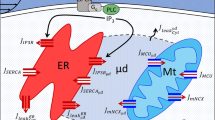Abstract
A model with which to elucidate the mechanism of Ca2+ release from, and Ca2+ loading in the sarcoplasmic reticulum (SR) by Ca2+ current (I Ca) in cardiac cells is proposed. The SR is assumed to be comprised of three functional subcompartments: (1) the main calcium store (MCS), which contains most of the calcium (both free and bound); (2) the releasable terminal (RT), which contains the calcium readily available for release; and (3) the longitudinal network of the SR (LSR), which sequesters and the transfers the sarcoplasmic calcium to the RT. A rapid increase of the Ca2+ concentration at the outer surface of the SR (Cae) due to the fast component ofI Ca activates and inactivates this surface, inducing the release of Ca2+ from the RT to the sarcoplasmic space. The RT in turn is further activated and inactivated by a increase in the concentration of sarcoplasmic Ca2+. The Ca2+ in the sarcoplasmic space is then sequestered by the LSR, leading to the reactivation of the RT. Further increase of Cae due to the slow component ofI Ca enhances the entry of Ca2+ into the MCS to be bound by the binding substance. The free Ca2+ released from the Ca-binding substance complex is transferred to the RT for subsequent release. The activation, inactivation and reactivation are Ca2+-mediated and time-dependent. The proposed model yields simulation of the many events qualitatively similar to those observed experimentally in skinned cardiac cells.
Similar content being viewed by others
Literature
Adler, D., A. Y. K. Wong, Y. Mahler and G. A. Klassen. 1985. Model of calcium movements in the mammalian myocardium: interval-strength relationship.J. theor. Biol. 113, 379–394.
Bassingthwaighte, J. B. and H. Reuter. 1972. Calcium movements and excitation-contraction coupling in cardiac cell. InElectric Phenomena in the Heart, W. C. DeMello (ed.), pp. 353–395. New York: Academic Press.
Beeler, G. W. and H. Reuter. 1977. Reconstruction of the action potential of ventricular myocardial fibers.J. Physiol. 268, 117–210.
Cannell, M. B. and D. G. Allen. 1984. Model of calcium movements during activation in the sarcomere of frog skeletal muscle.Biophys. J. 45, 913–925.
Cannell, M. B., J. R. Berlin and W. J. Lederer. 1987. Effect of membrane potential changes on the calcium transient in single rat cardiac muscle cells.Science 238, 1419–1423.
Fabiato, A. 1981. Myoplasmic free calcium concentration reached during the twitch of an intact isolated cardiac cell and during calcium-induced release of calcium from the sarcoplasmic reticulum of a skinned cardiac cell from the adult rat or rabbit ventricle.J. gen. Physiol. 78, 457–497.
Fabiato, A. 1982. Calcium release in skinned cardiac cells: variation with species, tissues and development.Fed. Proc. 41, 2238–2244.
Fabiato, A. 1983. Calcium-induced release of calcium from the cardiac sarcoplasmic reticulum.Am. J. Physiol. 245, C1-C14.
Fabiato, A. 1985a. Rapid ionic modifications during the aequorin-detected calcium transient in a skinned canine cardiac Purkinje cell.J. gen. physiol. 85, 189–246.
Fabiato, A. 1985b. Time and calcium dependence of activation and inactivation of calcium-induced release of calcium from the d-sarcoplasmic reticulum of a skinned canine cardiac Purkinje cell.J. gen. Physiol. 85, 247–289.
Fabiato, A. 1985c. Simulated calcium current can both cause calcium loading in and trigger calcium release from the sarcoplasmic reticulum of a skinned canine cardiac Purkinje cell.J. gen. Physiol. 85, 391–420.
Fabiato, A. 1985d. Appraisal of the hypothesis of the “depolarization-induced” release of calcium from the sarcoplasmic reticulum in skinned cardiac cells from the rat or pigeon ventricle. InStructure and Function of Sarcoplasmic Reticulum, S. Fleischer and Y. Tonomura (eds). New York: Academic Press.
Fabiato, A. and F. Fabiato. 1975. Contractions induced by a calcium-triggered release of calcium from the sarcoplasmic reticulum of single skinned cardiac cell.J. Physiol. 249, 469–495.
Fabiato, A. and F. Fabiato. 1977. Calcium release from the sarcoplasmic reticulum.Circ. Res. 40, 119–129.
Fabiato, A. and F. Fabiato. 1978. Calcium-induced release of calcium from the sarcoplasmic reticulum of skinned cell from adult, human, cat, rabbit, rat and frog hearts and from fetal and new-born rat ventricles.Ann. N.Y. Acad. Sci. 307, 491–522.
Hilgemann, D. W. and D. Noble. 1987. Excitation-contraction coupling and extracellular calcium transients in rabbit atrium: reconstruction of basic cellular mechanisms.Proc. R. Soc. Lond. B230, 163–205.
Holmberg, S. R. M. and A. J. Williams. 1989. Single channel recordings from human cardiac sarcoplasmic reticulum.Circ. Res. 65, 1445–1449.
Kitazawa, T. 1976. Physiological significance of Ca uptake by mitochondria in the heart in comparison with that by cardiac sarcoplasmic reticulum.J. Biochem. 80, 1129–1147.
Nayler, W. G., P. A. Poole-Wilson and A. Williams. 1979. Hypoxia and calcium.J. molec. Cell. Cardiol. 11, 683–706.
Rousseau, E., J. S. Smith, J. S. Henderson and G. Meissner. 1986. Single channel and45Ca flux measurements of the cardiac sarcoplasmic reticulum calcium channel.Biophys. J. 50, 1009–1014.
Safford, R. E. and J. B. Bassingthwaighte. 1977. Calcium diffusion in transient and steady states in muscle.Biophys. J. 20, 113–135.
Standen, N. B. and P. R. Stanfield. 1982. A binding site model for calcium channel inactivation that depends on calcium entry.Proc. R. Soc. Lond. B217, 101–110.
Solaro, R. J. and F. N. Briggs. 1974. Estimating the functional capabilities of sarcoplasmic reticulum in cardiac muscle: calcium binding.Circ. Res. 34, 531–540.
Winegrad, S. 1979. Electromechanical coupling in heart muscle. InHandbook of Physiology. Section 2:The Cardiovascular System: Vol. 1:The Heart, R. M. Berne, N. Sperelakis and S. R. Geiger (eds), pp. 393–428. Bethesda, MD: American Physiological Society.
Winegrad, S. 1982. Calcium release from cardiac sarcoplasmic reticulum.Ann. Rev. Physiol. 44, 451–462.
Wong, A. Y. K. and J. B. Bassingthwaighte. 1981. The kinetics of Ca−Na exchange in excitable tissue.Math. Biosci. 53, 275–310.
Wong, A. Y. K., A. Fabiato and J. B. Bassingthwaighte. 1987. Model of Ca release mechanism from the sarcoplasmic reticulum: Ca-mediated activation, inactivation and reactivation. InActivation, Metabolism and Perfusion of the Heart, S. Sideman and R. Beyar (eds), pp. 281–295. The Hague: Martinus Nijhoff.
Author information
Authors and Affiliations
Rights and permissions
About this article
Cite this article
Wong, A.Y.K., Fabiato, A. & Bassingthwaighthe, J.B. Model of calcium-induced calcium release mechanism in cardiac cells. Bltn Mathcal Biology 54, 95–116 (1992). https://doi.org/10.1007/BF02458622
Received:
Revised:
Issue Date:
DOI: https://doi.org/10.1007/BF02458622




